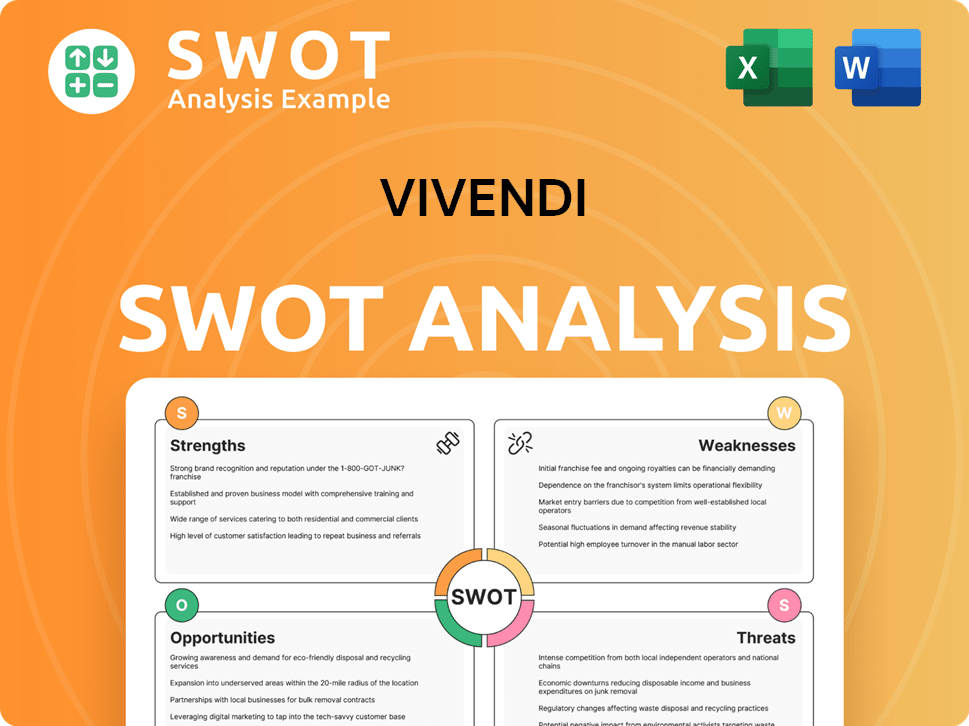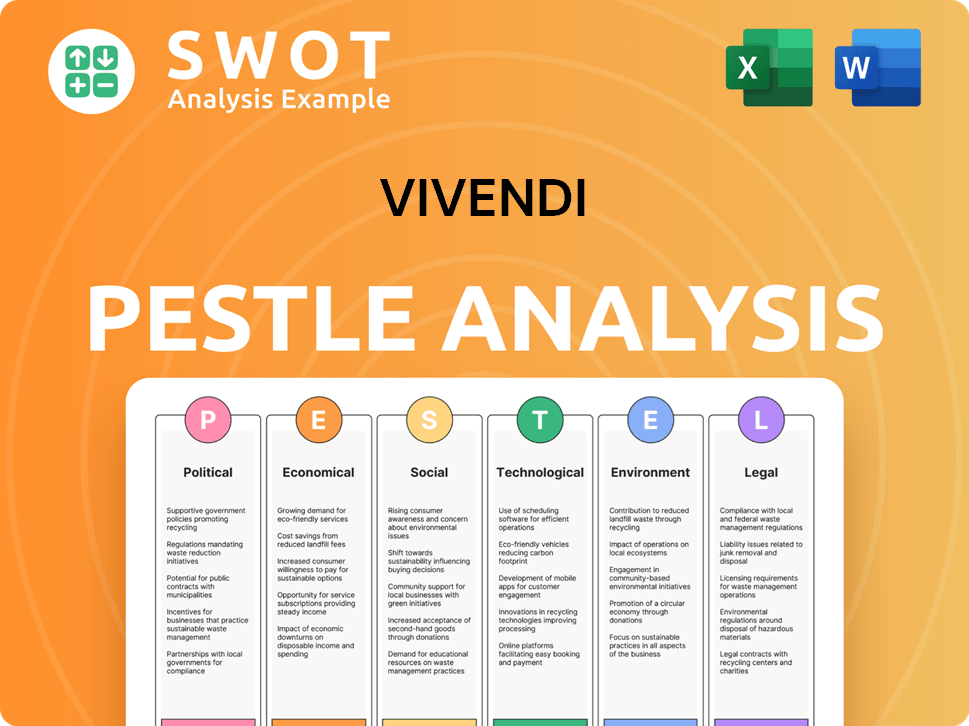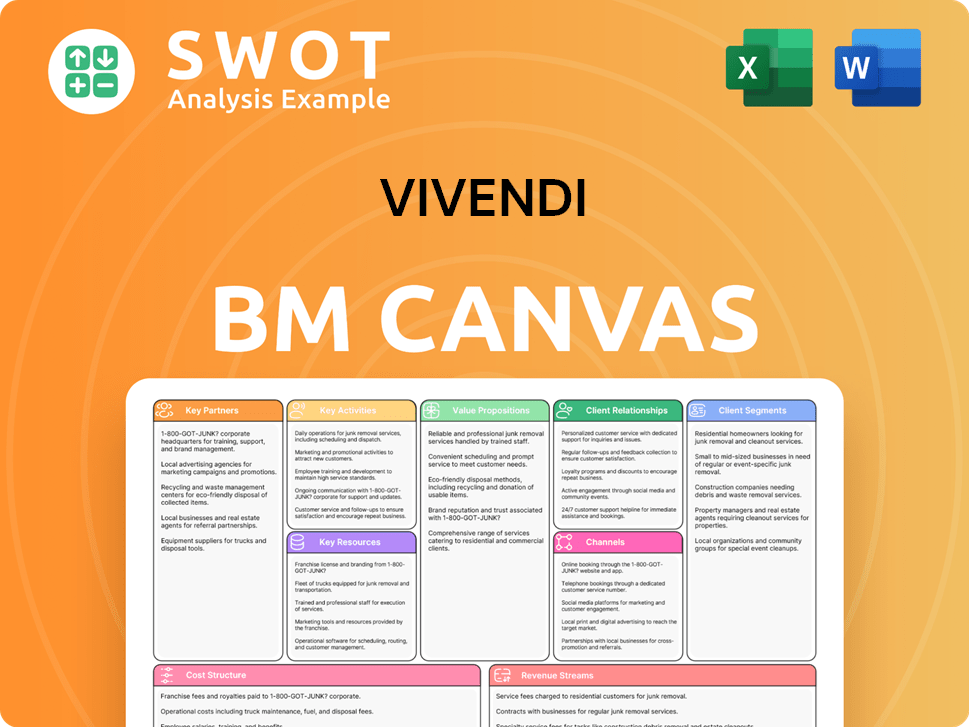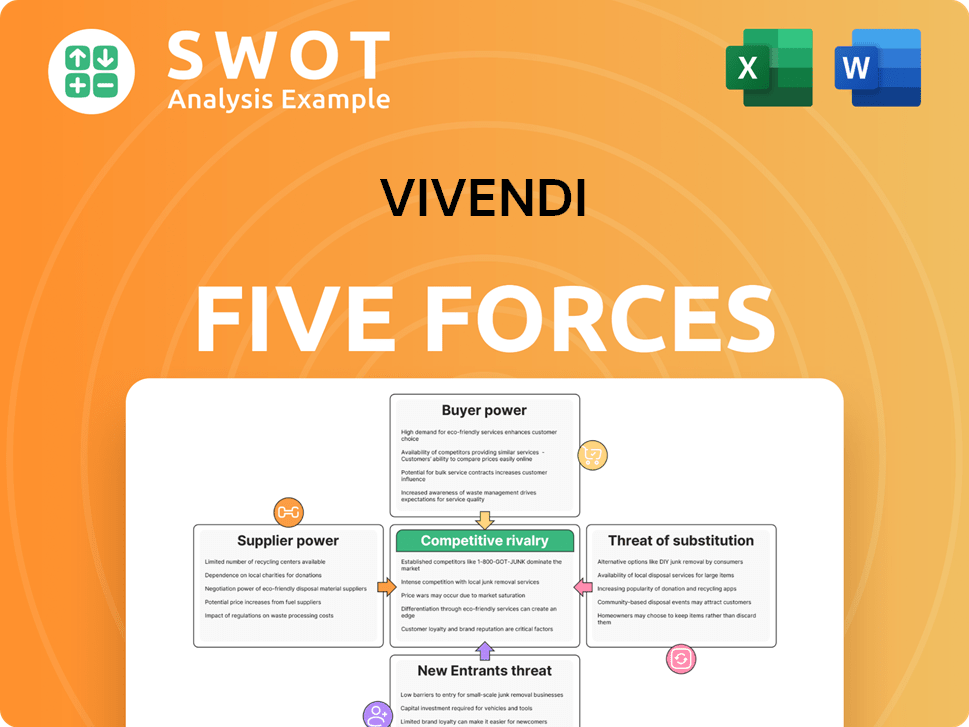Vivendi Bundle
How Does Vivendi Conquer the Global Media Market?
Vivendi, a titan in the media and content world, has consistently adapted its Vivendi SWOT Analysis to stay ahead. Its strategic acquisitions, like the pivotal Lagardère deal in late 2023, have reshaped its business model and market presence. Understanding Vivendi's sales and marketing approach is key to grasping its impressive growth trajectory.

This exploration of Vivendi's company strategy will dissect its sales and marketing strategy, revealing how this media company leverages content distribution and digital marketing to thrive. We'll examine Vivendi's brand positioning strategy, analyze its advertising campaigns, and explore how it generates revenue in a competitive landscape. Furthermore, we'll delve into Vivendi's market analysis and growth strategies, providing insights for investors and business strategists alike.
How Does Vivendi Reach Its Customers?
The sales channels of Vivendi are diverse, reflecting its wide-ranging media and entertainment assets. The company's approach encompasses online and offline methods, significantly influenced by its subsidiaries, including Canal+, Havas, Lagardère, and Gameloft. This comprehensive strategy is crucial for reaching a global customer base and maximizing revenue streams.
For its content and media businesses, Vivendi leverages digital platforms and direct-to-consumer models. This is particularly evident in Canal+ Group's distribution of cinema and audiovisual content. Additionally, Gameloft has expanded its presence across various platforms, capitalizing on the popularity of streaming and subscription services.
In publishing, Lagardère Publishing utilizes physical retail, wholesale distributors, and e-commerce. Lagardère Travel Retail operates a vast network of points of sale in transit hubs globally, serving as a significant physical retail channel. These channels contribute to Vivendi's overall sales and marketing approach.
Vivendi's digital platforms include online subscription services and direct-to-consumer models, particularly for its content businesses. Canal+ relies heavily on digital distribution to reach audiences worldwide. Gameloft has expanded its presence on PC, console, and digital platforms.
Physical retail channels are essential for Lagardère Publishing, which distributes through traditional retail locations and wholesalers. Lagardère Travel Retail operates over 4,900 points of sale in airports and train stations globally. These physical outlets support Vivendi's market expansion plans.
Vivendi's strategic partnerships are crucial for expanding its reach and revenue. The company holds strategic interests in other listed companies like Universal Music Group, which heavily relies on digital streaming services. These partnerships support Vivendi's growth strategies.
The spin-off of Canal+, Havas, and Louis Hachette Group in December 2024 marks a shift towards independent, publicly traded companies. While these entities are now independent, their sales channels and partnerships remain vital for their individual growth. This evolution is a key part of Vivendi's business model.
Vivendi's sales strategy focuses on leveraging both digital and physical channels to maximize reach and revenue. Digital platforms are crucial for content distribution, while physical retail remains important for publishing and travel retail. Strategic partnerships, such as with Universal Music Group, significantly contribute to Vivendi's financial performance in sales.
- Digital Distribution: Utilizing online platforms and direct-to-consumer models for content.
- Physical Retail: Employing traditional retail locations and travel retail outlets.
- Strategic Partnerships: Collaborating with other companies to expand reach and revenue.
- Spin-Offs: Creating independent entities to drive growth.
Vivendi SWOT Analysis
- Complete SWOT Breakdown
- Fully Customizable
- Editable in Excel & Word
- Professional Formatting
- Investor-Ready Format

What Marketing Tactics Does Vivendi Use?
The Vivendi sales strategy and marketing efforts are multifaceted, employing a blend of digital and traditional tactics to reach a broad audience. The company's approach is heavily influenced by its subsidiaries, which contribute to a diverse marketing ecosystem. This strategy is crucial for driving sales and maintaining a strong market presence.
Vivendi's
The company's marketing mix is evolving to prioritize digital transformation and innovation. This shift reflects the growing importance of digital engagement and the need to leverage technology for targeted marketing efforts. Vivendi's subsidiaries, like Havas, play a key role in this transformation, focusing on advanced technologies and data-driven solutions.
Vivendi heavily invests in digital marketing, including content marketing, paid advertising, and social media. This
Prisma Media saw significant growth in social media audiences, with TikTok followers doubling in Q1 2024 to 4.3 million. This demonstrates the effectiveness of Vivendi's social media strategy.
Digital affiliation and social media advertising revenues grew by over 25% compared to Q1 2023. This indicates the success of Vivendi's digital marketing efforts in generating revenue.
Vivendi Brand Marketing, established in 2019, provides strategic consultancy and content to brands worldwide. This division combines expertise from Havas with other Vivendi businesses.
Data-driven marketing, customer segmentation, and personalization are increasingly important. This approach helps Vivendi to better understand and target its audience.
Havas emphasizes its 'Converged' strategy, integrating global expertise, tools, and capabilities for optimized marketing solutions. This strategy uses data-driven insights, AI, and cutting-edge technology.
Vivendi's marketing tactics include a range of digital tools and strategies designed to build brand awareness and drive sales. These tactics are supported by strategic partnerships and investments in technology.
- Content Marketing: Creating and distributing valuable content to attract and engage the target audience.
- Paid Advertising: Utilizing platforms like Google Ads and social media to reach specific demographics.
- Social Media Marketing: Building a strong presence on social media platforms to interact with customers and promote content.
- Data Analytics: Using data to understand customer behavior and optimize marketing campaigns.
- Customer Relationship Management (CRM): Managing customer interactions and data to improve customer relationships.
- Strategic Partnerships: Collaborating with other companies to expand reach and enhance marketing efforts.
Vivendi PESTLE Analysis
- Covers All 6 PESTLE Categories
- No Research Needed – Save Hours of Work
- Built by Experts, Trusted by Consultants
- Instant Download, Ready to Use
- 100% Editable, Fully Customizable

How Is Vivendi Positioned in the Market?
Vivendi positions itself as a leader in the entertainment industry, emphasizing creativity and cultural influence. Its brand identity is built on a strong portfolio of assets, including music, television, film, publishing, and video games. This diversified structure allows Vivendi to navigate various sectors and mitigate risks effectively. Understanding the Vivendi sales strategy is key to appreciating how it leverages its brand.
The core of Vivendi's brand message revolves around providing access to quality, creative content through subscriptions. It aims to foster customer loyalty through its strong brands. Vivendi's brand value was estimated at €10.2 billion in 2023, which supports premium pricing strategies and contributes significantly to its annual revenue. This strong brand value is built over time through consistent marketing, positive customer experiences, and product quality.
The company's approach to brand positioning includes consistent marketing efforts and a focus on consumer engagement. Vivendi's Vivendi marketing strategy includes a focus on innovation and consumer engagement, which led to a 35% increase in customer engagement metrics in 2022. The company dynamically manages its investment portfolio to meet evolving public expectations. For more insights, explore the Growth Strategy of Vivendi.
Vivendi targets a broad audience, encompassing media consumers, investors, and industry professionals. This wide reach is crucial for its Vivendi business model. The company aims to attract those interested in entertainment, telecommunications, and content production.
Brand consistency is maintained across various channels through innovation and consumer engagement. Vivendi continuously transforms its businesses to meet evolving public expectations. This approach ensures the brand remains relevant in a dynamic market.
Vivendi reportedly spends approximately €1 billion annually on marketing and promotional activities. This significant investment supports its market presence. The allocation of the marketing budget is a key part of the Vivendi sales and marketing approach.
Vivendi's Vivendi media company faces a competitive landscape. The company actively manages its investment portfolio to respond to shifts in consumer sentiment and competitive threats. This dynamic approach is vital for maintaining its market position.
Vivendi Business Model Canvas
- Complete 9-Block Business Model Canvas
- Effortlessly Communicate Your Business Strategy
- Investor-Ready BMC Format
- 100% Editable and Customizable
- Clear and Structured Layout

What Are Vivendi’s Most Notable Campaigns?
Vivendi, a media company, has a sales and marketing strategy that is multifaceted, focusing on digital engagement, strategic partnerships, and leveraging its content to drive growth. The company's approach is best understood by examining the strategies of its key subsidiaries, which have evolved significantly following the spin-off of several entities in late 2024. This allows for a deeper understanding of Vivendi's overall business model and how it generates revenue through its various ventures.
The company's approach to sales and marketing is heavily influenced by the digital landscape, with a strong emphasis on online platforms, social media, and data-driven insights to reach target audiences. Vivendi's marketing budget allocation is strategically distributed across its subsidiaries, each tailored to their specific market and product offerings. This strategy aims to optimize customer relationship management and enhance brand positioning across its diverse portfolio.
Understanding the key campaigns of Vivendi and its former subsidiaries offers insights into its overall Vivendi sales strategy and Vivendi marketing strategy. This includes examining how the company approaches digital marketing strategy, advertising campaigns, and strategic partnerships to maintain its position in the competitive landscape. For more information on the Owners & Shareholders of Vivendi, you can explore their strategic direction.
Gameloft, a wholly-owned subsidiary, focuses on launching new games, such as a Dungeons & Dragons® title, which are supported by targeted marketing campaigns. These campaigns use gaming platforms, social media, and influencer collaborations to drive pre-orders and sales. Gameloft's operating expenses were down by 11% in 2024 due to cost reduction efforts, reflecting a focus on efficient marketing spend.
Havas, now an independent publicly traded company, employs a 'Converged' strategy, delivering integrated marketing solutions through innovation in data, technology, and AI. This approach supports numerous client-specific campaigns globally. Havas aims to drive growth and creativity through strategic acquisitions and increased collaboration.
Canal+ Group, aiming to become a global player, often launches significant communication and marketing campaigns to support its internationalization strategy. The proposed acquisition of MultiChoice in South Africa exemplifies this approach. Canal+ Group's revenue is expected to remain broadly stable year-on-year in 2024.
The overall Vivendi sales and marketing approach is characterized by a focus on digital engagement, strategic partnerships, and leveraging content libraries. These strategies are designed to create compelling narratives and experiences for target audiences. The company's growth strategies are supported by its ability to adapt and innovate within the media market.
Vivendi Porter's Five Forces Analysis
- Covers All 5 Competitive Forces in Detail
- Structured for Consultants, Students, and Founders
- 100% Editable in Microsoft Word & Excel
- Instant Digital Download – Use Immediately
- Compatible with Mac & PC – Fully Unlocked

Related Blogs
- What are Mission Vision & Core Values of Vivendi Company?
- What is Competitive Landscape of Vivendi Company?
- What is Growth Strategy and Future Prospects of Vivendi Company?
- How Does Vivendi Company Work?
- What is Brief History of Vivendi Company?
- Who Owns Vivendi Company?
- What is Customer Demographics and Target Market of Vivendi Company?
Disclaimer
All information, articles, and product details provided on this website are for general informational and educational purposes only. We do not claim any ownership over, nor do we intend to infringe upon, any trademarks, copyrights, logos, brand names, or other intellectual property mentioned or depicted on this site. Such intellectual property remains the property of its respective owners, and any references here are made solely for identification or informational purposes, without implying any affiliation, endorsement, or partnership.
We make no representations or warranties, express or implied, regarding the accuracy, completeness, or suitability of any content or products presented. Nothing on this website should be construed as legal, tax, investment, financial, medical, or other professional advice. In addition, no part of this site—including articles or product references—constitutes a solicitation, recommendation, endorsement, advertisement, or offer to buy or sell any securities, franchises, or other financial instruments, particularly in jurisdictions where such activity would be unlawful.
All content is of a general nature and may not address the specific circumstances of any individual or entity. It is not a substitute for professional advice or services. Any actions you take based on the information provided here are strictly at your own risk. You accept full responsibility for any decisions or outcomes arising from your use of this website and agree to release us from any liability in connection with your use of, or reliance upon, the content or products found herein.